Contents
Oscillators form the core of many synthesis systems. We get good vibrations as we explain how they work and what they do…
Virtually every form of synthesis (with the possible exception of physical modelling popularised in Yamaha’s range of VL synths) follows three main stages: tone generation > tone-shaping > volume shaping. The tone generation section can take several forms but the most common is the oscillator which is the main sound source in analogue synthesisers and software emulations.
Oscillators generate sound by, er, oscillating. That is, their circuitry basically changes or oscillates between two states very quickly, and just as a vibrating string produces a sound, so the oscillating electronic circuit generates a waveform that can be amplified and used as a sound source. And that’s as technical as we’re going to get here!
The output of an oscillator has three parameters – frequency or pitch, amplitude or volume and waveform or tone. We can see how they relate to a sound by looking at the simplest of all waveforms, a sine wave.
Give me a sine
Oscillators produce repetitive or cyclic waveforms which are usually measured in Hertz (abbreviated to Hz). The faster the oscillator vibrates, the more cycles there will be in a given time and the higher the frequency or pitch will be.
Here we have one full cycle of a sine wave. The distance from the highest to lowest points (technically, the peaks) is its amplitude and the greater the amplitude, the louder it will be.
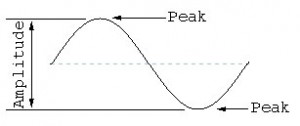

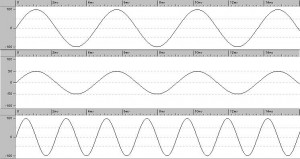
In control
One of the main features of analogue synthesisers is the way the various modules pass messages to each other. It’s all done with voltages. When you press a key on an analogue synth it sends a specific voltage to the oscillator which generates a particular pitch. Higher and lower keys produce higher and lower voltages and correspondingly higher and lower notes. Analogue oscillators, therefore, are commonly known as VCOs or Voltage Controlled Oscillators.
Voltage control was used with synth modules such as oscillators, filters, amplifiers and envelope generators. It became such a natural and relatively intuitive method of control that even now, many digital synthesisers emulate the VCO routing concept sometimes quite specifically as in Reason’s Control Voltage cabling. Even though digital oscillators don’t generate waveforms in the same way as analogue synths, many soft synths adopt analogue synth methods and terminology.
Nice tone
The tone of a waveform is determined by the harmonics it contains. Harmonics are additional frequencies higher than the fundamental and usually at a lower volume Harmonics have a natural mathematical relationship to each other – the 2nd harmonic is twice the frequency of the fundamental, the 3rd harmonic is three times the fundamental frequency, the 6th harmonic is six times the frequency and so on. The science of sound doesn’t get much easier than this!
The harmonics in a waveform determines its shape. We can easily see the amplitude and frequency of a wave by looking at it. However, each waveform has its own harmonic content and its own tone, and it’s virtually impossible to know what it will sound like by looking at it. The best approximation we can do is to say that the more complex a waveform is, the more likely it is to have lots of harmonics and sound richer, certainly in comparison to a sine wave.
Look at that wave
A handful of waveforms are commonly used in synthesis, each with a distinctive wave shape and sound.
The simplest is the sine wave which we’ve already looked at which consists only of a single fundamental frequency.It is often used for flute and drawbar organ sounds.

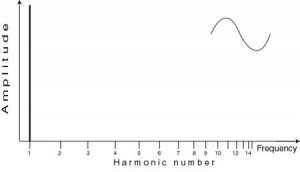
Being so rich in harmonics, sawtooth waves are commonly used for brass, strings and some woodwind sounds.

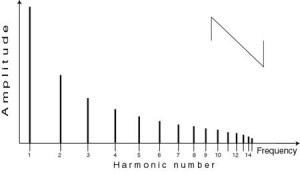

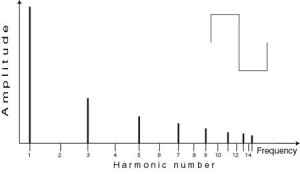
Although triangle waves do contain harmonics, they are not very dominant and triangle waves sound very sine-like. Some synthesisers dispense with a sine wave in favour of a triangle waveform.

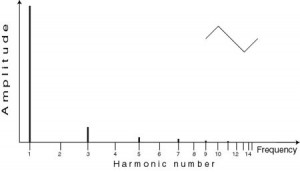
Mark this space
One of the most interesting waveforms is the pulse wave because the wave can be changed to alter its harmonic content. It looks like an offset square wave. Whereas in a square wave the upper and lower sections of a cycle are the same – square – in a pulse wave these can be varied. Technically, the upper part is called the ‘mark’ and the lower part the ‘space’. Synth controls for adjusting them are called ‘pulse width’ or ‘mark/space ratio’ controls.

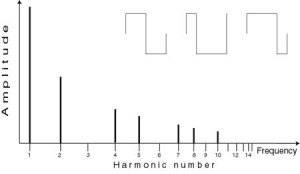
Now, a feature of pulse waves is that harmonics that are multiples of the right-hand ratio number are absent. The square wave with a 1:2 ratio has no even harmonics – harmonics 2, 4, 6, 8, 10 and so on are absent. A mark/space ratio of 1:3 would have no harmonics that are multiples of 3 – 3, 6, 9, 12 and so on.
As a pulse wave becomes narrower it becomes thinner and takes on a nasal quality. It is commonly used for oboe and harpsichord sounds.
What’s that noise
The final waveform we’ll look at is noise. This is a hissing, rushing sound similar to what you hear when a TV signal is lost or you tune between radio stations.


Noise comes in several colourful varieties. The most common is white noise which contains all audio frequencies in equal proportions. Pink noise is the next most popular. It contains fewer high frequencies, sounds less hissy and has a rushing sound. You can create an approximation of pink noise by running white noise through a low pass filter (see The Quick Guide To EQ And Filters).
Oscillators – the takeaway
Tech terms
Hertz
The tech term for ‘cycles per second’, named after Heinrich Rudolph Hertz (1857-1894). If a sound source vibrates at 100 cycles per second it has a frequency of 100Hz.
Modulator
A synth module whose output is used to change another.
A
So that instruments can play in tune with each other, they must sound the same pitch when they play the same note. In 1939 it was agreed that the A above Middle C should be 440Hz (in the 19th century is had been as low as 435Hz) so use this when setting an oscillator’s or synth’s pitch.
Analogue synths use a process called subtractive synthesis. You start with one of the waveforms just described and run it through a filter to remove some harmonics – hence subtractive synthesis. Most forms of synthesis are subtractive to some degree – as soon as you add a filter to the process you are going to remove something!
One alternative to subtractive synthesis is additive synthesis which is simply adding waveforms together. If you have enough oscillators – and time and patience! – you can try this by adding sine waves together. Create a sawtooth wave, for example, by mixing sine waves at the frequency and proportion of the harmonics as described above.
Home in on the range
As well as generating waveforms, most oscillators have range and tuning controls. Range sets the octave and traditionally this was calibrated in ‘feet’, a throwback to the days of organs when the length of an organ pipe determined its pitch. Options will typically be 2′, 4′, 8′, 16′ and 32′. Each foot is an octave and 8′ is the octave starting at Middle C. Many modern synths calibrate their oscillators in octaves.
Tuning controls fine tune an oscillator to a specific pitch. Many oscillators have coarse and fine tuning controls. In the early days of analogue synths, oscillators were notoriously unstable and kept drifting out of tune. They were often switched on hours before a performance to let them stabilise but the musician would often be playing it with one hand and tuning it with another.
Modern instruments are far more stable and digital synths and software should never have tuning problems. However, it’s common to run two oscillators together and to detune one slightly against the other to thicken the sound.
How low can you go?
We’ve been talking about oscillators as sound sources but they can be used as modulators, too. The LFO (Low Frequency Oscillator) is simply an oscillator that oscillates at a low frequency. It could be so low that it takes several seconds or even minutes to complete a cycle.
LFOs are typically used to add vibrato to a sound by applying a sine wave at a frequency of around 5-8Hz to the pitch. Applying it to volume produces tremolo and applying it to a filter to produce variations in tone.
When selecting an oscillator, it’s important to pick one that generates the type of sound you want for your raw material. This overview of oscillators will help you do that..
For more information on Oscillators…
Synthesiser documentation should contain information about the oscillators it contains and may we modestly suggest the Quick Guide to Analogue Synthesis.









